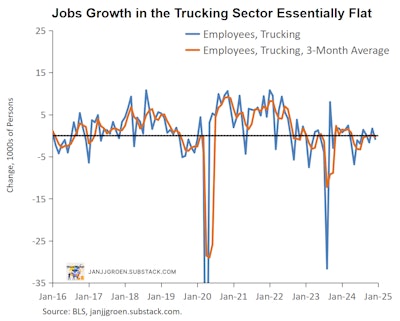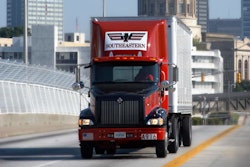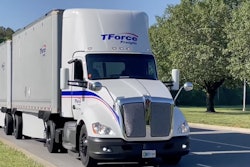Jobs in the trucking sector may be showing signs of stabilization, according to Bureau of Labor Statistics data.
The December trucking jobs report showed a loss of 800 jobs on a seasonally adjusted basis. Additionally, job numbers for October and November revisions were downward, cutting another 800 and 2,000 jobs.
Despite these declines, total job losses over the past four months are only 500, suggesting the job market in the trucking sector has been relatively stable. However, employment is still down 5,900 jobs compared to December 2023 and 42,000 jobs from the peak in July 2022.
The unemployment rate in the U.S. transportation sector in December was 4.3%, the same as December 2023 but higher than the 2.8% from December 2019.
Jan Groen, economist and founder of Macro Market Notes, said based on the December jobs report payroll growth in the trucking sector has been essentially flat since September.

“This marks a stabilization from the dynamics observed over the summer when trucking payrolls contracted,” Groen said. “It appears the sector has found a new steady state, as the sector completed its downward adjustment following the explosive growth of the sector during 2020-2022.”
[Related: Freight market poised for gradual growth in 2025 amid economic shifts, analysts say]

Find out what 2025 looks like for the trucking industry
Join us for this webinar Join us on February 13, 2025, at 2 p.m. Eastern, as two leading trucking economic experts discuss all the trucking industry influences in play (micro, macro and political), and give an outlook of what is likely in store in the quarters ahead in 2025. This webinar is brought to you by Valvoline.
David Spencer, vice president of market intelligence at Arrive Logistics, said the recent steadiness of the trucking job market reflects similar trends in trucking rates.
“Over the past year, truckload rates have stabilized and have begun to move into inflationary conditions over the past few months,” Spencer said. “It would make sense that stability in the operating environment for carriers would lead to stability in the employment situation. This is a good sign for trucking companies, so long as the current conditions remain stable or continue to improve.”
While demand outlook for trucking remains uncertain, Spencer pointed to stable conditions as carriers have recently prioritized asset utilization and operational efficiency.
Shannon Gabriel, vice president of leadership solutions practice at TBM Consulting, echoed signs of stabilization. There’s been dips and rises throughout the year, Gabriel said, with some specific events to blame, such as an election putting employers in “hold mode,” as well as weather-related impacts.
However, Gabriel said 2025 is still starting off strong overall. In December, Gabriel’s findings showed that there were 612,000 active resumes in the sector, while January showed 658,000 active resumes.
“I anticipate trucking jobs will increase this year at a slow but steady rate,” she added.
Another dataset for context
On the other hand, Mazen Danaf, senior economist at Uber Freight, said that the BLS data may offer limited insight to the employment rate as it also includes other sectors (such as, bus and train drivers and air transportation) in transportation.
Long-distance truckload employment data may be a more relevant indicator. Danaf said the segment has experienced a slow decline in employment over the past two years, signaling a gradual correction in capacity.
“While we have seen a 2% drop from the peak, employment in this sector is still about 4% above the pre-pandemic level, which already was an oversupplied market,” Danaf said. It’s also worth noting that BLS’ data is set for significant revisions following the upcoming annual recalibration.
A market recovery
Spencer said the shift to significant job growth may not occur until mid-year or later, though he believes that the market has begun its recovery.
“Rates are not likely to fall further from here, and we should see a stable to growing rate environment improve trucking profitability – at a minimum increased revenue/mile,” Spencer said. “This would bode well for a return to a growth mindset for these companies, or at least a reprieve from persistently low rates, and an opportunity to reinvest in growth or replacing or repairing worn or old equipment.”
Danaf said that Uber Freight expects a milder tightening compared to the previous tight markets, since there are no demand shocks ahead.
“We anticipate gradual capacity correction and gradual demand recovery to start shifting the balance in the favor of carriers, but at a very slow rate – unlike 2020 where demand skyrocketed overnight and carriers laid off more than 5% of their workforce,” Danaf said.
So, are rates returning to COVID-era levels? That’s still unlikely, Spencer said.
“But double-digit spot rate growth is probable in 2025 based on what we are seeing with the market’s sensitivity to typical seasonal disruptions and recent weather impacts,” Spencer added.












